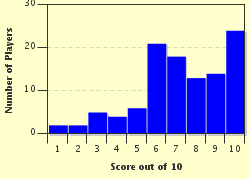Quiz Answer Key and Fun Facts
1. There is only one European capital city where it is possible to stand on the boundary between the western and eastern hemispheres. The city in question was founded by the Romans in around 47AD; has a network of 'lost' underground rivers including the Tyburn, the Walbrook and the Fleet; and is home to an underground railway system known as the 'Tube'. What is its name?
2. Which European country, with a coastline on the Black Sea, contains the historical region of Transylvania (of 'Dracula' fame)?
3. Mount Korab, a peak of about 2,800 metres (or 9,100 feet), lies on the border between Macedonia and which other Balkan state that has an eagle as its national symbol?
4. In 2004, the European Union gained ten member states, one of which is home to the Masurian Lake District, a Baltic Sea coastline and northern parts of the Carpathian mountain range. Can you name it?
5. The largest country in western Europe is bordered to the south-east by the Alps and to the south-west by the Pyrenees. It contains many famous skiing destinations including Val d'Isère and Courchevel, which have both hosted World Cup events. What is it called?
6. A German city situated on the River Neckar is home to both the oldest university in Germany and a ruined castle, the royal base of the Electors Palatine for around 300 years. Which one?
7. Shopska salad - consisting of diced tomato, cucumber, onion and pepper, topped with sirene cheese and parsley - is a dish that originates from which European country, the majority of whose northern border is defined by the River Danube?
8. Which southern European nation has a recorded history dating back over 10,000 years and a territory that includes well over 1,000 Mediterranean islands, including Santorini, Cephalonia, and Corfu?
9. One heavily forested northern European country is divided into 25 landskap or provinces (including Lappland, Halland and Dalsland), which have historical and cultural significance, but no modern administrative functions. Which country fits this description?
10. What is the proper name in English for the 'Emerald Isle', a European island located in the Atlantic Ocean, which is divided between two different sovereign nations and is home to the Giant's Causeway World Heritage Site?
Source: Author
Fifiona81
This quiz was reviewed by FunTrivia editor
Pagiedamon before going online.
Any errors found in FunTrivia content are routinely corrected through our feedback system.

